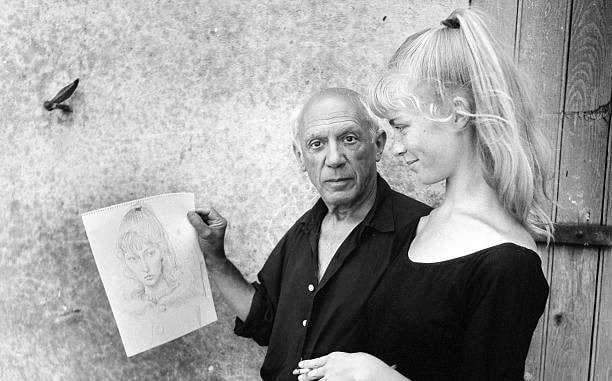The #MeToo movement has finally come for Picasso

A few miles east of Aix-en-Provence in the south of France, in the grounds of a fortified manor house on the slopes of Mont Sainte-Victoire, there is a modest grassy mound. This unassuming spot is the last resting place of Pablo Picasso, who died, aged 91, 50 years ago tomorrow.
To mark the anniversary, perhaps his descendants will gather at the Château de Vauvenargues, which remains in his family. Elsewhere, though, people will be dancing on his grave. How come? The bronze sculpture of a large-breasted woman looking like a prehistoric fertility figure atop his tomb provides a clue: it was inspired by his lover Marie-Thérèse Walter, who was seduced by the Spanish artist, then in his forties, when she was underage.
“For me,” Picasso supposedly once said, “there are only two kinds of women – goddesses and doormats.” These days, his reputation as a tyrannical, philandering, misogynistic embodiment of toxic masculinity is making audiences, especially younger ones, shun his art.
Don’t believe me? That’s understandable. Just five years ago, Tate Modern’s Picasso 1932 exhibition attracted more than 500,000 visitors; today, to commemorate his death, the French and Spanish governments are collaborating on “Picasso Celebration 1973-2023”, a programme of 50 shows and events.
He may have been art history’s Bluebeard, but Picasso remains as popular as ever, doesn’t he?

Perhaps, yet increasingly, since the #MeToo movement, there have been “attacks” on him, according to Cécile Debray, the president of the Musée Picasso in Paris, and not only on social media.
Two years ago, for instance, a group of students wearing T-shirts printed with slogans such as “Picasso, women abuser” staged a protest inside Barcelona’s Museu Picasso.
One prominent takedown is part of a word-of-mouth hit for Netflix. “I f---ing hate [Picasso],” says the Australian comedian (and art-history graduate) Hannah Gadsby during Nanette, a 69-minute-long performance recorded live at the Sydney Opera House in 2017. After describing him as a “b--- sack”, and rechristening him as “Picky-a---hole”, they go on to declare: “Picasso suffered the mental illness of misogyny.” Oops, they joke, “I’ve ruined any chance of getting a job in a gallery now.”
In fact, this summer, New York City’s Brooklyn Museum will present her exhibition It’s Pablo-matic: Picasso According to Hannah Gadsby, juxtaposing Picasso with feminist artists.
Awareness of the artist’s misogyny is now mainstream, says the Picasso scholar Elizabeth Cowling. “Generally,” she explains, “it’s thought that he was a vile human being whose treatment of women was abominable and that looking at his work is a form of collusion, and, therefore, shouldn’t be done.” Professor emerita in the history of art at the University of Edinburgh, Cowling says she has been told by “a number of active lecturers in art-history departments” that “many students” now refuse to engage with his work.
For Debray, this fit of moralising is “really frightening”. Although she doesn’t want to “defend” his character, and accepts that he treated women in a “problematic” manner (“I agree his behaviour wouldn’t be bearable today,” she tells me), she also points out that Picasso “belongs to another period”, and was “born at the end of the 19th century, into the macho culture of southern Spain”.
For Cowling, Picasso, who became an international celebrity after the war, with a hedonistic profile as a Breton shirt-wearing playboy frolicking beside the Med, “made the big mistake, with hindsight, of parading his private life, and boasting about his sexuality”. Fundamentally, says Debray, the debate revolves around an “old question”: is it desirable, even possible, to separate an artist from their work? “Whether you agree with it or not,” Catherine Morris, co-curator of the forthcoming exhibition at the Brooklyn Museum, says: “Picasso’s biography and artistic output have become a flashpoint for conversations contemporary audiences want to have about many heroic men of history whose real-life behaviour has long been overlooked.”

Cowling holds a different view: “This may be an attempt to hide my head in the sand, but I don’t approve of a biographical attitude to art history,” she says. For her, establishing a “direct relationship” between an artist’s life and work is necessarily a “falsification”: focusing excessively on biography, she argues, “leaves out an understanding of the creative imagination”, and is “just the tip of the iceberg, in terms of the actuality of the person”. Thanks to John Richardson’s “entertaining” multi-volume biography, she adds, “People think they really know Picasso. Of course, they don’t.”
Or, as Debray puts it, in more Gallic terms: “We are not in bed with Picasso. We will never know the truth.”
Cowling would encourage the artist’s detractors to consider aspects of his work beyond biography, such as “execution, originality, imagination, wit, things like that” – as well as “signs of tenderness and affection” in paintings often said to be misogynistic. When, for instance, she first encountered Picasso’s Seated Nude (1959), which depicts a distorted woman squatting to reveal her genitals in the manner of a top-shelf centrefold, she recalls feeling “absolutely staggered” by its “gentleness”. She says: “A moving feeling of love emanated from it, and I was just overwhelmed. Very unexpected.”
Women in Picasso’s art, Cowling suggests, are an “expressive vehicle” for universal emotions.
Debray agrees, citing his famous Weeping Woman series that depicts his mistress at the time: “Now, young people looking at these paintings say, ‘Ah, Dora Maar was weeping because Picasso wasn’t kind to her.’ But the weeping woman is the Mater Dolorosa [Our Lady of Sorrows], or Spain, or even Picasso.” In works of art, she explains, “you have this identification”. For Cowling, the only surprise is the tardiness of the “backlash” against Picasso – which, she says, she has been expecting “for 20 years”. “This finally could kill him off,” she tells me. “But it’s not going to kill him off for long. Because he’s an incredibly original artist, productive on so many levels, inexhaustible. And he’s never going to be completely forgotten.”


